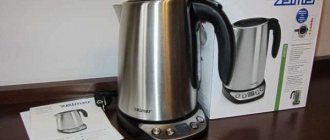Useful tips
If you forget to turn off the heat under a pot or frying pan in time, be prepared for two consequences. Firstly, there is smoke, which will certainly form there, and which will not be easy to clean. Secondly, there is a burning smell, which is not only unpleasant, but also harmful.
Today there are many products for cleaning kitchen utensils. But if for some reason you do not have the opportunity to use them, then several traditional methods will help you.
Click on the topic you're interested in to jump straight to it.
How to get rid of burning - method I
How to get rid of burning - method II
How to get rid of burning - method III
How to clean up smoke in nature
How to get rid of burning smell
If the pan smells like fish
The smell of fish can be removed quite easily and quickly. The most effective and common remedy is vinegar. There are many ways to use vinegar to remove fish odor.
If the smell is not strong
1 way:
- Moisten a soft sponge for washing dishes with vinegar (table vinegar, not essence!)
- Wipe the bottom and sides of the pan with a sponge.
- Wash the pan thoroughly using dishwashing detergent.
Method 2:
- Mix 1 l. water and 1 tbsp. vinegar.
- Wash the pan with the resulting solution.
- Rinse the pan with water.
If the smell is strong
1 way:
- Pour vinegar into the bottom of the pan.
- Keep covered overnight.
- Wash the pan with detergent.
Method 2:
- Pour vinegar into the bottom of the pan.
- Close the lid and heat over low heat.
- Wash the cooled pan with detergent.
You can also remove the faint smell of fish using lemon:
- Wipe the pan with lemon juice.
- Wash the pan thoroughly with detergent.
From clothes
The fishy smell permeates not only the kitchen utensils, but also everything around: towels, oven mitts, an apron, curtains and the clothes themselves. Therefore, if you do not take the necessary measures in time, then most likely you will have to throw things away. What to do:
- washing machine - this option is the very first one that comes to mind, but most often it is unsuccessful, because it does not completely remove all the smell. Therefore, add lemon juice and conditioner with citrus filler to the washing powder. This perfectly neutralizes all the unpleasant aroma;
- soaking the fabric - to achieve a better result, before washing, dilute laundry soap in water and soak the items for 50 minutes;
- table salt solution - if things smell like rotten fish, then make a highly concentrated solution of salt and soak all things for 30-40 minutes. Then wash as usual;
- boiling - if the smell was so strong that neither soaking nor washing helped, then there is another option that is the most effective - boil all things in water and laundry soap. But in this case the fabric may be damaged;
- dry cleaning – this option is suitable for those who do not have time and have the opportunity to give their things to professionals.
Important!
After washing, you should not leave things in the washing machine. It is better to hang them outside to dry.
How to get rid of the smell of burnt food in a pan
If food is burnt in a pan, you should immediately soak the dishes in hot water with detergent or soap and wash them after a while. After this, the unpleasant odor may disappear.
If it remains, then a proven remedy for combating the smell of burnt food is soda.
If the smell is strong
- Mix 1 tsp in a saucepan. baking soda and 1 l. water, put on fire.
- Bring the mixture in the saucepan to a boil.
- Wash the cooled pan using detergent.
Lemon juice can also help remove the smell of burnt food.
- Apply lemon juice to the bottom and sides of the pan.
- After 10-15 minutes, wash the pan with detergent.
If the smell is not strong
- Apply a little baking soda to a stiff dishwashing sponge.
- Wipe the pan with a sponge.
- Wash the pan with detergent.
Mustard can also cope well with the smell of burnt food.
- Rub the pan with mustard and wait 10-15 minutes.
- Wash the pan using detergent.
How to clean a frying pan without ruining the product
When starting to clean your pan, it's helpful to remember four tips.
- Take into account the specifics of the coating. You should choose the appropriate method for removing contaminants depending on the material from which the product is made.
- Give preference to “natural” remedies. Kitchen appliances come into direct contact with food, so it is much safer to use more environmentally friendly and health-safe compounds rather than household chemicals.
- Don't put off cleansing for too long. Fresh dirt is much easier to remove than stubborn dirt.
- Take precautions. Removing stubborn carbon deposits requires the use of aggressive methods, so the skin of your hands should be protected by wearing gloves. During work, it is also worth opening the windows so that the fumes released do not poison the air in the room.
The table below will help you take into account the characteristics of the material from which the frying pan is made when choosing a cleaning method.
Table - What frying pans made of different materials are “afraid of”
| Material/Coating | Do not use for cleaning |
| — Cast iron | - Dishwashers |
| - Stainless steel | — Metal scourers and scrapers; - products containing ammonia and chlorine; - baking soda and salt dissolved in cold water |
| — Aluminum | — Metal scourers and scrapers; - products containing abrasives |
| — Teflon | — Metal scourers and scrapers; — products containing abrasive substances; — heating more than 200 °C; - powdered formulations (including pastes with salt, soda, crushed coffee beans) |
| — Ceramics | — Metal scourers and scrapers; — products containing abrasive substances; — temperature changes; - powdered formulations (including pastes with salt, soda, crushed coffee beans) |
If the pot smells musty
If the pan smells musty, this indicates the presence of fungus, even if it is not visible.
There are different ways to remove mold.
Mildew detergent:
- Apply washing powder to the bottom and walls of the pan.
- Wash the pan thoroughly.
- After some time, wash the pan using detergent.
Removing mold with boiling water:
- Fill the pan with boiling water.
- When the pan has cooled, wash it thoroughly.
How to remove mold smell with peroxide:
- Wipe the pan with a soft sponge soaked in hydrogen peroxide.
- Wait 20 minutes.
- Wash the pan with detergent.
Vinegar against mold in a pan:
- Wipe the pan with a soft sponge soaked in vinegar and leave for 5-10 minutes.
- Wash the pan with detergent.
Coffee grounds will help remove mold smell:
- Apply coffee grounds to the pre-washed pan in an even layer.
- Wash the pan thoroughly using detergent.
A separate topic - cast iron
Cast iron frying pans are no longer in such demand in the modern world, but many housewives prefer them: they say that a dish prepared in such a dish is much tastier. Unfortunately, practical products do not have good non-stick properties, so soot and greasy deposits form on them faster. Fortunately, you can clean a cast-iron frying pan from many years of soot using strong methods: the durable material is practically “indestructible.” Before “global” cleaning, you need to remove food residues from cast iron cookware. This is especially true for a pancake pan, which during use becomes covered with pieces of dried dough.
Mechanical grinding
Cast iron is not afraid of aggressive mechanical stress. Two methods can be used.
- Special tools. Using a sandblaster (a tool that uses a directed jet of sand to remove not only carbon deposits, but also rust) or a grinding machine, a cast iron frying pan will be cleaned in a matter of minutes. The use of these methods will require male help.
- Conventional metal scrapers. Cast iron is not afraid of such tools, so you can arm yourself with tough devices and feel free to start scrubbing a frying pan covered with soot. This method is very labor-intensive. Is it worth resorting to? There are also simpler options.
Fire influence
Fire removes fat and carbon deposits from a cast iron frying pan without damaging the material. The advantage of this method is its absolute safety for the product. But the housewife needs to take precautions. Pollution is removed without chemicals. Two methods are used.
- Bonfire. When going to the country or to nature, you can take with you a cast iron frying pan covered with soot. And just throw the product into the fire. When the fire goes out, you need to wait for the frying pan to cool, wash it with regular detergent, and wipe dry. The device will be as good as new. This method can only be used outdoors in places where lighting a fire is permitted.
- Gas-burner. In case of emergency, you can expose a cast iron frying pan to a flame using a gas burner or a blowtorch, securing the product to a metal stand. Using this method requires special care; windows must be open.
When using “hot” methods, it is imperative to follow fire safety precautions, and also free the frying pan from wooden and plastic parts.
Oven treatment for rust
Cast iron is susceptible to corrosion, which is why products made from this metal should always be wiped dry. But if trouble could not be avoided, you can get rid of rust on a cast iron frying pan using heat in the oven. You need to act in four steps.
- Preheat the oven to 120°C, first lining the bottom with foil.
- Place the pan in the broiler for 40 minutes.
- Take the product out, grease it with vegetable oil, and put it in the oven again. The temperature must be increased to 230 °C.
- After an hour, take out the pan, wait until it cools completely, and treat it with vegetable oil again.
Restoring non-stick properties
Many housewives complain that after cleaning a cast-iron frying pan, food begins to burn strongly during cooking. To fix this, you can carry out a simple procedure by treating the product with salt. You need to act by adhering to six recommendations.
- Pour table salt onto the bottom of the frying pan and heat the product over low heat for about 20 minutes.
- When you hear the salt crackling, you need to start stirring it, while touching the bottom with a spoon. Do this for another 20 minutes.
- Add salt. Wait until the product cools down.
- Rinse the pan and heat it again.
- After waiting for the product to heat up, use a spatula or silicone brush to lubricate the bottom with vegetable oil.
- If you notice that the oil has begun to burn, carefully remove the residue with a napkin and pour in fresh oil. Repeat three times.
The result is a shiny, non-stick bottom that you don't have to scrub too hard to clean. It is useful to repeat this oiling from time to time.
Eating food cooked in a dirty pan is hazardous to your health. Yes, and the appearance of products covered with soot and greasy deposits is very sad. That's why it's important to know how and what to clean a frying pan at home. But, having returned the product to its original purity, you need to try to no longer allow severe contamination: this will save both time and nerves.
Video on the topic
Smell from pot while cooking
Cooking acidic foods, such as cabbage, in a pan can cause an unpleasant odor.
A piece of bread placed in a pan in which something sour is being cooked will absorb an unpleasant odor. To prevent it from getting soggy in the pan, it is better to first put it in a sieve. You can stretch gauze over the walls of the pan and place the bread on it, or squeeze a piece between the lid and the walls of the pan.
Nowadays, to get rid of the smell in a pan, you can use both time-tested methods and recently introduced chemicals. But it's better to prevent them from appearing
Useful tips for housewives to note:
- To ensure that the fish releases less odors during frying, place peeled and sliced potatoes into the oil.
- Some housewives advise dripping a little lemon juice into the oil - this also prevents the aroma of the fish from spreading.
- If you do not want the smell of fish to transfer into subsequent dishes cooked in this frying pan, have a separate frying pan for the fish. And then the question of how to remove the smell of fish from a frying pan will disappear on its own.
- Some women, in order to make the fish emit less odor during cooking, immerse it for several minutes in a solution of water, vinegar, pepper and bay leaf. For the same purpose, you can rub salt into the fish carcass, wait 15 minutes and rinse.
- Another way to neutralize the odor is to use dill seeds. Just sprinkle them on fish that is ready to be frozen, or vice versa - taken out of the freezer to defrost. Then there will be less unpleasant aromas during cooking.
- When preparing fish stock, add a little milk - this will not only improve the taste, but also neutralize the smell.
Use of purchased funds
You can buy kitchen utensil cleaning products at a household chemical store. When choosing a product, it is important not only to take into account the recommendations of other housewives, but also:
- study the composition - it is desirable that the product does not contain abrasive substances, and stainless steel frying pans are also “afraid” of ammonia and chlorine;
- pay attention to the scope of application - products for aluminum frying pans may not be suitable for products with Teflon coating.
The choice of cleaning product is individual, however, judging by the reviews, the following have proven themselves well:











